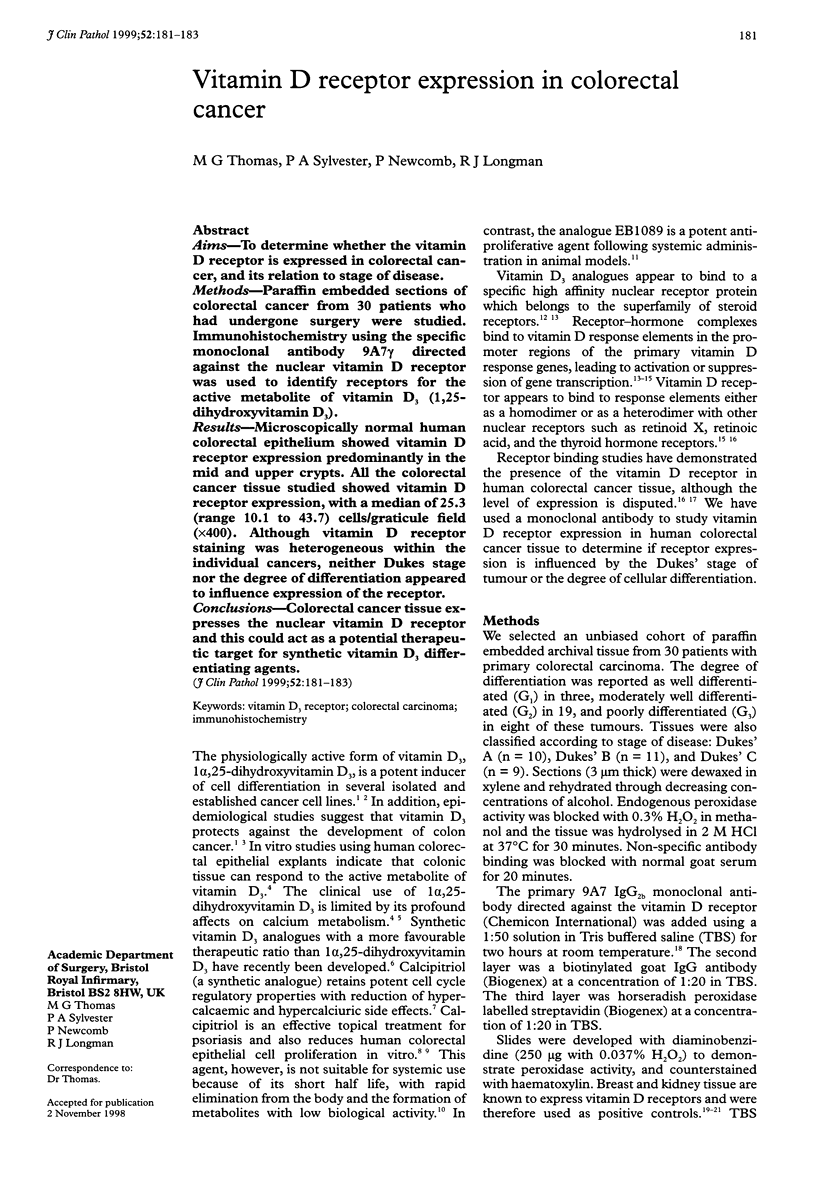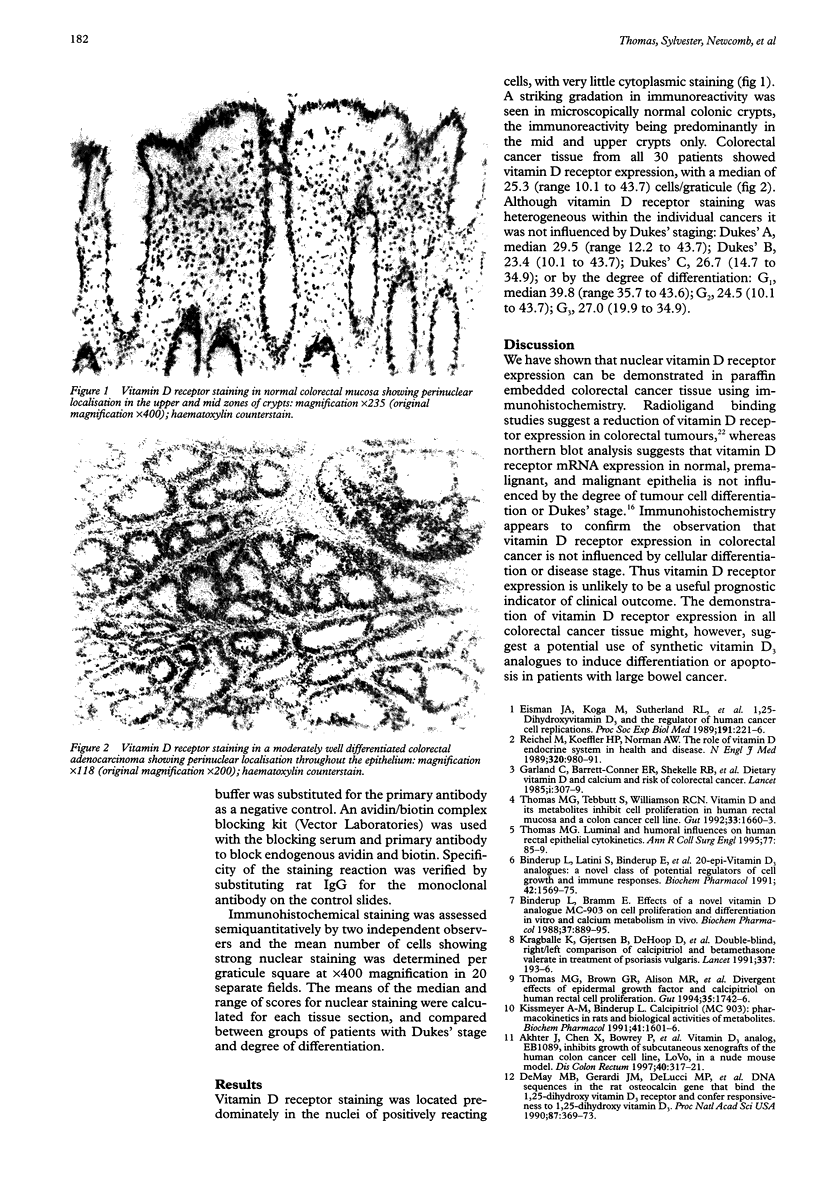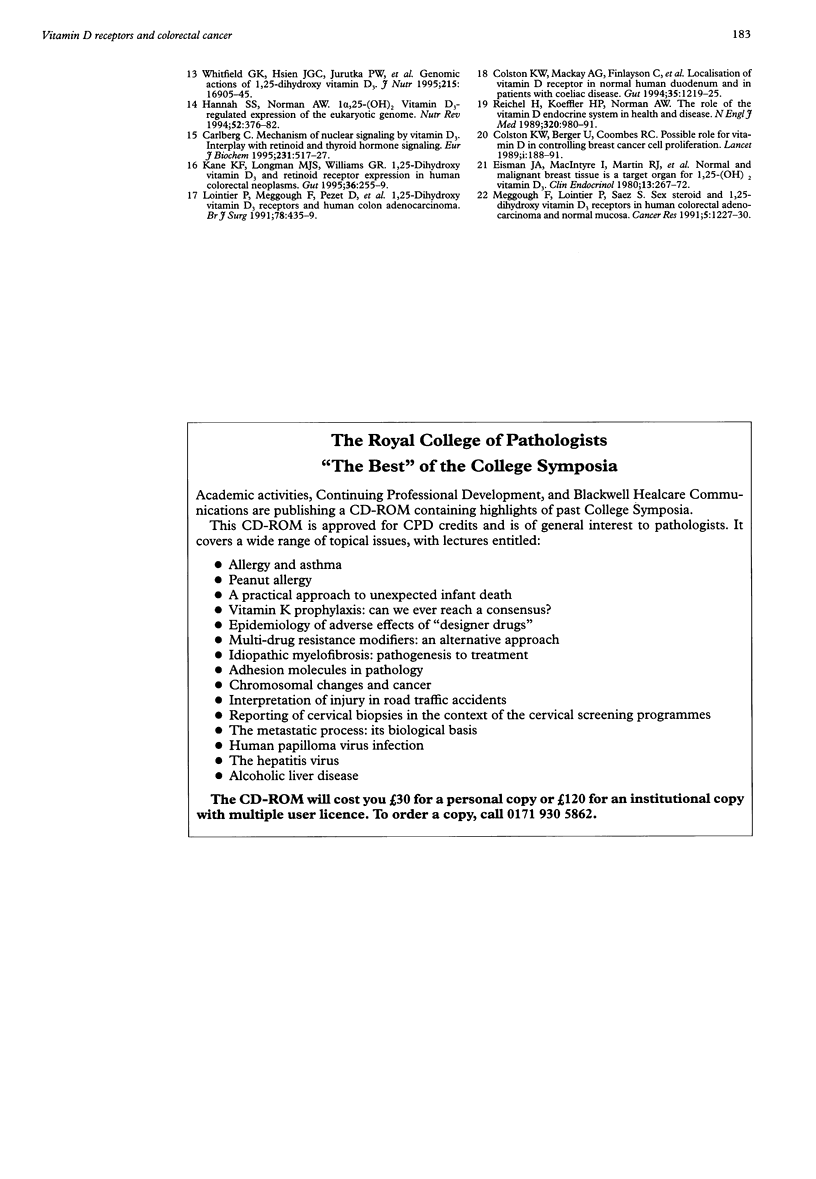Abstract
AIMS: To determine whether the vitamin D receptor is expressed in colorectal cancer, and its relation to stage of disease. METHODS: Paraffin embedded sections of colorectal cancer from 30 patients who had undergone surgery were studied. Immunohistochemistry using the specific monoclonal antibody 9A7 gamma directed against the nuclear vitamin D receptor was used to identify receptors for the active metabolite of vitamin D3 (1,25-dihydroxyvitamin D3). RESULTS: Microscopically normal human colorectal epithelium showed vitamin D receptor expression predominantly in the mid and upper crypts. All the colorectal cancer tissue studied showed vitamin D receptor expression, with a median of 25.3 (range 10.1 to 43.7) cells/graticule field (x 400). Although vitamin D receptor staining was heterogeneous within the individual cancers, neither Dukes stage nor the degree of differentiation appeared to influence expression of the receptor. CONCLUSIONS: Colorectal cancer tissue expresses the nuclear vitamin D receptor and this could act as a potential therapeutic target for synthetic vitamin D3 differentiating agents.
Full text
PDF


Images in this article
Selected References
These references are in PubMed. This may not be the complete list of references from this article.
- Akhter J., Chen X., Bowrey P., Bolton E. J., Morris D. L. Vitamin D3 analog, EB1089, inhibits growth of subcutaneous xenografts of the human colon cancer cell line, LoVo, in a nude mouse model. Dis Colon Rectum. 1997 Mar;40(3):317–321. doi: 10.1007/BF02050422. [DOI] [PubMed] [Google Scholar]
- Binderup L., Bramm E. Effects of a novel vitamin D analogue MC903 on cell proliferation and differentiation in vitro and on calcium metabolism in vivo. Biochem Pharmacol. 1988 Mar 1;37(5):889–895. doi: 10.1016/0006-2952(88)90177-3. [DOI] [PubMed] [Google Scholar]
- Binderup L., Latini S., Binderup E., Bretting C., Calverley M., Hansen K. 20-epi-vitamin D3 analogues: a novel class of potent regulators of cell growth and immune responses. Biochem Pharmacol. 1991 Sep 27;42(8):1569–1575. doi: 10.1016/0006-2952(91)90426-6. [DOI] [PubMed] [Google Scholar]
- Carlberg C. Mechanisms of nuclear signalling by vitamin D3. Interplay with retinoid and thyroid hormone signalling. Eur J Biochem. 1995 Aug 1;231(3):517–527. [PubMed] [Google Scholar]
- Colston K. W., Berger U., Coombes R. C. Possible role for vitamin D in controlling breast cancer cell proliferation. Lancet. 1989 Jan 28;1(8631):188–191. doi: 10.1016/s0140-6736(89)91204-x. [DOI] [PubMed] [Google Scholar]
- Colston K. W., Mackay A. G., Finlayson C., Wu J. C., Maxwell J. D. Localisation of vitamin D receptor in normal human duodenum and in patients with coeliac disease. Gut. 1994 Sep;35(9):1219–1225. doi: 10.1136/gut.35.9.1219. [DOI] [PMC free article] [PubMed] [Google Scholar]
- Demay M. B., Gerardi J. M., DeLuca H. F., Kronenberg H. M. DNA sequences in the rat osteocalcin gene that bind the 1,25-dihydroxyvitamin D3 receptor and confer responsiveness to 1,25-dihydroxyvitamin D3. Proc Natl Acad Sci U S A. 1990 Jan;87(1):369–373. doi: 10.1073/pnas.87.1.369. [DOI] [PMC free article] [PubMed] [Google Scholar]
- Eisman J. A., Koga M., Sutherland R. L., Barkla D. H., Tutton P. J. 1,25-Dihydroxyvitamin D3 and the regulation of human cancer cell replication. Proc Soc Exp Biol Med. 1989 Jul;191(3):221–226. doi: 10.3181/00379727-191-42912. [DOI] [PubMed] [Google Scholar]
- Eisman J. A., Macintyre I., Martin T. J., Frampton R. J., King R. J. Normal and malignant breast tissue is a target organ for 1,25-(0H)2 vitamin D3. Clin Endocrinol (Oxf) 1980 Sep;13(3):267–272. doi: 10.1111/j.1365-2265.1980.tb01053.x. [DOI] [PubMed] [Google Scholar]
- Garland C., Shekelle R. B., Barrett-Connor E., Criqui M. H., Rossof A. H., Paul O. Dietary vitamin D and calcium and risk of colorectal cancer: a 19-year prospective study in men. Lancet. 1985 Feb 9;1(8424):307–309. doi: 10.1016/s0140-6736(85)91082-7. [DOI] [PubMed] [Google Scholar]
- Hannah S. S., Norman A. W. 1 alpha,25(OH)2 vitamin D3-regulated expression of the eukaryotic genome. Nutr Rev. 1994 Nov;52(11):376–382. doi: 10.1111/j.1753-4887.1994.tb01368.x. [DOI] [PubMed] [Google Scholar]
- Kane K. F., Langman M. J., Williams G. R. 1,25-Dihydroxyvitamin D3 and retinoid X receptor expression in human colorectal neoplasms. Gut. 1995 Feb;36(2):255–258. doi: 10.1136/gut.36.2.255. [DOI] [PMC free article] [PubMed] [Google Scholar]
- Kissmeyer A. M., Binderup L. Calcipotriol (MC 903): pharmacokinetics in rats and biological activities of metabolites. A comparative study with 1,25(OH)2D3. Biochem Pharmacol. 1991 Jun 1;41(11):1601–1606. doi: 10.1016/0006-2952(91)90160-7. [DOI] [PubMed] [Google Scholar]
- Kragballe K., Gjertsen B. T., De Hoop D., Karlsmark T., van de Kerkhof P. C., Larkö O., Nieboer C., Roed-Petersen J., Strand A., Tikjøb G. Double-blind, right/left comparison of calcipotriol and betamethasone valerate in treatment of psoriasis vulgaris. Lancet. 1991 Jan 26;337(8735):193–196. doi: 10.1016/0140-6736(91)92157-w. [DOI] [PubMed] [Google Scholar]
- Lointier P., Meggouh F., Dechelotte P., Pezet D., Ferrier C., Chipponi J., Saez S. 1,25-Dihydroxyvitamin D3 receptors and human colon adenocarcinoma. Br J Surg. 1991 Apr;78(4):435–439. doi: 10.1002/bjs.1800780416. [DOI] [PubMed] [Google Scholar]
- Meggouh F., Lointier P., Saez S. Sex steroid and 1,25-dihydroxyvitamin D3 receptors in human colorectal adenocarcinoma and normal mucosa. Cancer Res. 1991 Feb 15;51(4):1227–1233. [PubMed] [Google Scholar]
- Mitchell M. D., Bibby J. G., Hicks B. R., Redman C. W., Anderson A. B., Turnbull A. C. Thromboxane B2 and human parturition: concentrations in the plasma and production in vitro. J Endocrinol. 1978 Sep;78(3):435–441. doi: 10.1677/joe.0.0780435. [DOI] [PubMed] [Google Scholar]
- Reichel H., Koeffler H. P., Norman A. W. The role of the vitamin D endocrine system in health and disease. N Engl J Med. 1989 Apr 13;320(15):980–991. doi: 10.1056/NEJM198904133201506. [DOI] [PubMed] [Google Scholar]
- Reichel H., Koeffler H. P., Norman A. W. The role of the vitamin D endocrine system in health and disease. N Engl J Med. 1989 Apr 13;320(15):980–991. doi: 10.1056/NEJM198904133201506. [DOI] [PubMed] [Google Scholar]
- Thomas M. G., Brown G. R., Alison M. R., Williamson R. C. Divergent effects of epidermal growth factor and calcipotriol on human rectal cell proliferation. Gut. 1994 Dec;35(12):1742–1746. doi: 10.1136/gut.35.12.1742. [DOI] [PMC free article] [PubMed] [Google Scholar]
- Thomas M. G. Luminal and humoral influences on human rectal epithelial cytokinetics. Ann R Coll Surg Engl. 1995 Mar;77(2):85–89. [PMC free article] [PubMed] [Google Scholar]
- Thomas M. G., Tebbutt S., Williamson R. C. Vitamin D and its metabolites inhibit cell proliferation in human rectal mucosa and a colon cancer cell line. Gut. 1992 Dec;33(12):1660–1663. doi: 10.1136/gut.33.12.1660. [DOI] [PMC free article] [PubMed] [Google Scholar]




